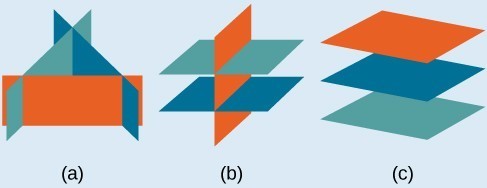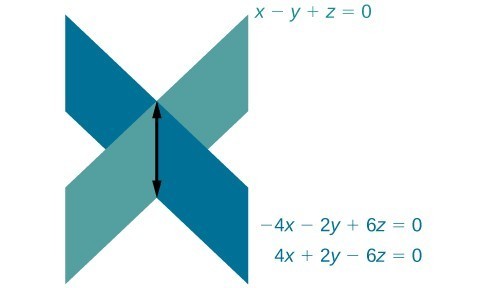Read: Inconsistent and Dependent Systems in Three Variables
Learning Objectives
- Identify an inconsistent system of equations in three variables
- Identify a dependent system of equations in three variables
Infinitely Many or No Solutions
- Systems that have an infinite number of solutions are those which, after elimination, result in an expression that is always true, such as [latex]0=0[/latex]. Graphically, an infinite number of solutions represents a line or coincident plane that serves as the intersection of three planes in space. The graphic below shows how three planes can intersect to form a line giving the system infinitely many solutions.
 Infinitely many solutions.
Infinitely many solutions.- Systems that have no solution are those that, after elimination, result in a statement that is a contradiction, such as [latex]3=0[/latex]. Graphically, a system with no solution is represented by three planes with no point in common. Three parallel planes (c), two parallel planes and one intersecting plane (b), three planes that intersect the other two but not at the same location (a).

Example
Solve the following system.[latex]\begin{array}{ll}\text{ }x - 3y+z=4\,\,\,\,\,\,\,\,\,\,\,\,\left(1\right)\\ \,\,\,\,\,\,-y-4z=7\,\,\,\,\,\,\,\,\,\,\,\,\,\left(2\right)\,\,\,\,\\\,\,\,\,\,\,\,\,2y+8z=-12\,\,\,\,\,\,\,(3)\end{array}[/latex]
Answer: If you multiply equation [latex](2)[/latex] by [latex]2[/latex] and add [latex](2)[/latex] and [latex](3)[/latex] together, you can eliminate y and solve for [latex]z[/latex]. First, multiply equation [latex](2)[/latex] by [latex]2[/latex].
[latex]\begin{array}\,\,\,\,\,\,2(-y-4z=7)\\-2y-8z=14\end{array}[/latex]
Next, add equations [latex](2)[/latex] and [latex](3)[/latex] together to eliminate y and solve for [latex]z[/latex].
[latex]\begin{array}\,\,\,\,\,\,-2y-8z=14\\\underline{+2y+8z=-12}\\0+0=2\\0=2\end{array}[/latex]
Recall that when we were solving systems with two variables, a non-true solution such as [latex]0=2[/latex] implied that there was no solution to the system.
This can happen with a system of three variables as well.
Answer
No solution, or DNEExample
Find the solution to the given system of three equations in three variables.[latex]\begin{array}{rr}\hfill \text{ }2x+y - 3z=0& \hfill \left(1\right)\\ \hfill 4x+2y - 6z=0& \hfill \left(2\right)\\ \hfill \text{ }x-y+z=0& \hfill \left(3\right)\end{array}[/latex]
Answer: First, we can multiply equation [latex](1)[/latex] by [latex]-2[/latex] and add it to equation [latex](2)[/latex].
[latex]\begin{array} −4x−2y+6z=0 \hfill& \text{equation }\left(1\right)\text{multiplied by }−2 \\ 4x+2y−6z=0\hfill&\left(2\right) \end{array}[/latex]
We do not need to proceed any further. The result we get is an identity, [latex]0=0[/latex], which tells us that this system has an infinite number of solutions. As shown in the figure below, two of the planes are the same and they intersect the third plane on a line. The solution set is infinite, as all points along the intersection line will satisfy all three equations.
Answer
There are an infinite number of solutions.Summary
- A system with three variables can have one, none, or many solutions
- A system with no solutions will have a non-true result when solving
- A system with many solutions will have an identity result when solving
Licenses & Attributions
CC licensed content, Original
- Revision and Adaptation. Provided by: Lumen Learning License: CC BY: Attribution.
CC licensed content, Shared previously
- Ex 4: System of Three Equations with Three Unknowns Using Elimination (No Solution). Authored by: James Sousa (Mathispower4u.com). License: CC BY: Attribution.
- Ex 5: System of Three Equations with Three Unknowns Using Elimination (Infinite Solutions). Authored by: James Sousa (Mathispower4u.com). License: CC BY: Attribution.
CC licensed content, Specific attribution
- Precalculus. Provided by: OpenStax Authored by: OpenStax College. Located at: https://cnx.org/contents/[email protected]:1/Preface. License: CC BY: Attribution.
